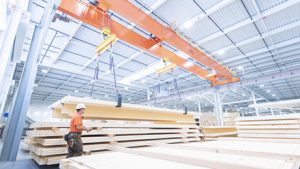Katerra’s cross-laminated timber (CLT) factory in Spokane Valley, Washington, US has received Chain of Custody (CoC) certification under three major certification programs: Sustainable Forestry Initiative (SFI), Forest Stewardship Council (FSC), and the Programme for the Endorsement of Forest Certification (PEFC). Source: Timberbiz
Katerra, is a technology company in the construction industry, and has worked with SCS Global Services – an international leader in third-party certification, validation, and verification of environmental and sustainability performance – to certify its factory.
These certification programs address a variety of factors including biodiversity and wildlife habitat, sustainable harvest levels, water quality protection, and pesticide use. Chain of Custody (CoC) certification traces the path of wood from certified forests through the supply chain to the final product. CoC certified wood products are incentivized or required by green building standards such as LEED and the Living Building Challenge, as well as by many corporate, government and institutional purchasing programs.
Katerra customers can choose between CoC-certified and non-certified CLT.
Katerra’s Spokane Valley factory will initially produce Cross-Laminated Timber (CLT) structural systems, with plans to expand into production of additional mass timber products in the future.
The Spokane Valley manufacturing facility is Katerra’s first mass timber production line, occupying 29 acres in eastern Washington state. The 270,000 sq ft facility features one of the largest CLT presses currently in operation globally, as well as easy access to rail lines and interstate highways for ease of transport options.
Katerra offers CLT in a growing number of layup configurations of various thickness, ranging from 3.5 to 12.4 inches. In plan dimension, Katerra presses 10 ft. or 12 ft. nominal width by 60 ft. long master panels on each press cycle. Each master panel is subdivided into individual panel elements by a CNC machine to meet project-specific requirements.








